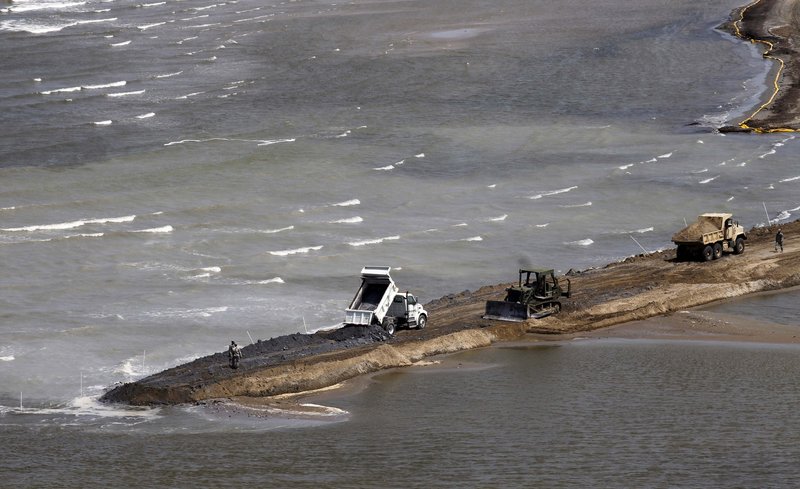ON THE GULF OF MEXICO – Black Hawk helicopters peppered Louisiana’s barrier islands with 1-ton sacks of sand Monday to bolster the state’s crucial wetlands against an epic oil spill in the Gulf of Mexico.
At the site of the ruptured well a mile below the surface, a remote-controlled submarine shot chemicals into the maw of the massive undersea leak to dilute the flow, further evidence that BP expects the gusher to keep erupting into the Gulf for weeks or more.
Crews using the deep-sea robot tried to thin the oil — which is rushing up from the seabed at a pace of about 210,000 gallons per day — after getting approval from the Environmental Protection Agency, BP PLC officials said.
Two previous tests were done to determine the potential impact on the environment, and the third round of spraying was to last into early today.
BP engineers, casting about after an icelike buildup thwarted their plan to siphon off most of the leak using a 100-ton containment box, pushed ahead with other potential short-term solutions, including using a smaller box and injecting the leak with junk such as golf balls and pieces of tire to plug it. If it works, the well will be filled with mud and concrete and abandoned.
“This is the largest, most comprehensive spill response mounted in the history of the United States and the oil and gas industry,” BP senior vice president Kent Wells said.
Workers were simultaneously drilling a relief well, the solution considered most permanent, but that was expected to take up to three months.
At least 4 million gallons were believed to have leaked since an April 20 drilling rig blast killed 11. If the gusher continues unabated, it will surpass the Exxon Valdez disaster as the nation’s worst spill by Father’s Day.
The new containment device is much smaller, about 4 feet in diameter, 5 feet tall and weighing just under two tons, said Doug Suttles, BP PLC chief operating officer. Unlike the bigger box, it will be connected to a drill ship on the surface by a pipe-within-a-pipe when it’s lowered, which will allow crews to pump heated water and methanol immediately to prevent the ice buildup.
In Grand Isle, at the tip of the Louisiana boot, National Guard helicopters dropped sandbags on a breached section of beach, and piles of dirt were pushed together to make a dam, keeping oil from reaching the marshes.
As the sandbags plopped into place, workers farther inland used pumps and other structures to divert fresh water from the Mississippi River into the marshlands, hoping it would help push back the oily salt water lapping at the coast. The floodworks had been installed to help rebuild Louisiana’s shrinking wetlands by injecting sediment-rich water from the river.
“We’re trying to save thousands of acres of marsh here in this area, where the shrimp lay their eggs, where the fin fish lay their eggs, where the crabs come in and out,” said Chett Chiasson, executive director of the Greater Lafourche Port Commission. “We’re trying to save a heritage, a way of life, a culture that we know here in recreational and commercial fishing.”
Send questions/comments to the editors.



Comments are no longer available on this story